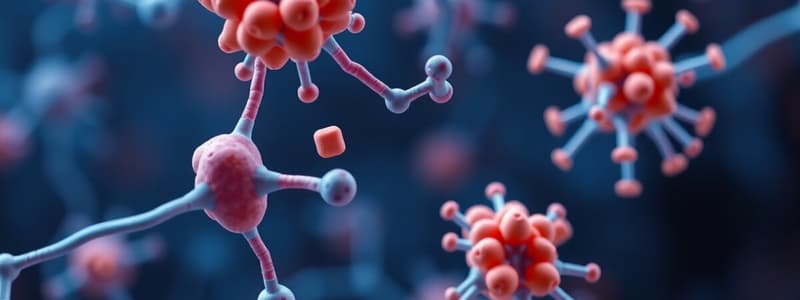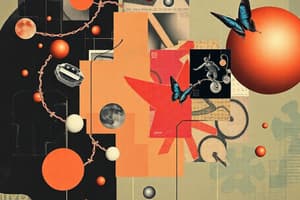Podcast
Questions and Answers
What does caffeine tolerance primarily result from?
What does caffeine tolerance primarily result from?
- Decreased metabolic rate
- Upregulation of adenosine receptors (correct)
- Enhanced receptor sensitivity
- Increased production of adenosine
What does pharmacokinetics primarily study?
What does pharmacokinetics primarily study?
- Changes in drug concentration in the body over time (correct)
- How the drug interacts with receptor proteins
- The relationship between drug concentrations and their effects
- The side effects of various drugs
What is the definition of pharmacodynamics?
What is the definition of pharmacodynamics?
- The measurement of drug absorption rates
- The methods of drug delivery in treatments
- The study of genetic variations in drug response
- The effects of drug concentration on the body (correct)
Which of the following describes a main function of receptors?
Which of the following describes a main function of receptors?
Which factor does NOT contribute to individual variation in drug response?
Which factor does NOT contribute to individual variation in drug response?
Which type of drug receptor is primarily involved in quick responses such as muscle contraction?
Which type of drug receptor is primarily involved in quick responses such as muscle contraction?
What is a drug-target interaction?
What is a drug-target interaction?
Which component is NOT a receptor type typically discussed?
Which component is NOT a receptor type typically discussed?
What is the primary action of propranolol?
What is the primary action of propranolol?
What characterizes a Type A adverse drug reaction?
What characterizes a Type A adverse drug reaction?
What is considered the minimum effective concentration (MEC) of a drug?
What is considered the minimum effective concentration (MEC) of a drug?
What happens if drug levels fall below the therapeutic range?
What happens if drug levels fall below the therapeutic range?
What defines the minimum toxic concentration (MTC) of a drug?
What defines the minimum toxic concentration (MTC) of a drug?
How do Type B adverse drug reactions differ from Type A?
How do Type B adverse drug reactions differ from Type A?
What does the therapeutic range of a drug indicate?
What does the therapeutic range of a drug indicate?
Procaine penicillin can cause which of the following adverse effects?
Procaine penicillin can cause which of the following adverse effects?
In what scenario would a drug likely reach concentrations above the toxic level?
In what scenario would a drug likely reach concentrations above the toxic level?
Which of the following statements about metoprolol is correct?
Which of the following statements about metoprolol is correct?
What describes the relationship between the structural characteristics of a drug and its biological effect?
What describes the relationship between the structural characteristics of a drug and its biological effect?
Which of the following is an example of a non-specific pharmacodynamic interaction?
Which of the following is an example of a non-specific pharmacodynamic interaction?
What defines a full agonist in terms of receptor interaction?
What defines a full agonist in terms of receptor interaction?
How do competitive antagonists function in relation to agonists?
How do competitive antagonists function in relation to agonists?
In the dose-response relationship, what is primarily measured?
In the dose-response relationship, what is primarily measured?
Which of the following is an example of an indirect action of a drug?
Which of the following is an example of an indirect action of a drug?
What type of agonist produces submaximal responses even when bound to receptors?
What type of agonist produces submaximal responses even when bound to receptors?
What is the main effect of antacids on the body?
What is the main effect of antacids on the body?
What is the primary mechanism of action described for most drugs?
What is the primary mechanism of action described for most drugs?
Which of the following examples illustrates direct action of a drug?
Which of the following examples illustrates direct action of a drug?
How does an indirect action of a drug differ from a direct action?
How does an indirect action of a drug differ from a direct action?
What effect does amphetamine have according to the content provided?
What effect does amphetamine have according to the content provided?
Which of the following best describes a drug's mechanism of action?
Which of the following best describes a drug's mechanism of action?
Which drug is mentioned as causing bronchodilation?
Which drug is mentioned as causing bronchodilation?
What is a common characteristic of pharmacodynamic interactions?
What is a common characteristic of pharmacodynamic interactions?
What desired effect results from the action of amlodipine?
What desired effect results from the action of amlodipine?
What is the primary action of full agonists at receptors?
What is the primary action of full agonists at receptors?
Which of the following best describes a partial agonist?
Which of the following best describes a partial agonist?
Which drug is an example of a competitive antagonist?
Which drug is an example of a competitive antagonist?
How do ACE inhibitors function in terms of drug action?
How do ACE inhibitors function in terms of drug action?
What is the role of amphetamines in neurotransmitter dynamics?
What is the role of amphetamines in neurotransmitter dynamics?
What effect do MAO inhibitors have on neurotransmitters?
What effect do MAO inhibitors have on neurotransmitters?
How do antagonists differ from agonists?
How do antagonists differ from agonists?
What characterizes non-competitive antagonism?
What characterizes non-competitive antagonism?
What effect does a competitive antagonist have when agonist concentration is already high?
What effect does a competitive antagonist have when agonist concentration is already high?
Which scenario describes the effect of a non-competitive antagonist?
Which scenario describes the effect of a non-competitive antagonist?
What is likely to happen to Bambi's heart rate if the β1 agonist adrenaline is in excess while being treated with metoprolol?
What is likely to happen to Bambi's heart rate if the β1 agonist adrenaline is in excess while being treated with metoprolol?
In the scenario where Tigger is given ketamine and glutamate levels increase, what can be expected?
In the scenario where Tigger is given ketamine and glutamate levels increase, what can be expected?
What characterizes a competitive antagonist in relation to receptor activity?
What characterizes a competitive antagonist in relation to receptor activity?
What happens to the biological effect when an agonist is administered in excess of a non-competitive antagonist?
What happens to the biological effect when an agonist is administered in excess of a non-competitive antagonist?
Which statement is accurate regarding the relationship between competitive antagonists and agonists?
Which statement is accurate regarding the relationship between competitive antagonists and agonists?
How does a non-competitive antagonist interact with an agonist?
How does a non-competitive antagonist interact with an agonist?
Flashcards
Direct Action Drugs
Direct Action Drugs
Drugs that bind to a receptor and trigger a response, like a key fitting into a lock.
Competitive antagonist
Competitive antagonist
An antagonist that binds to the same site as the agonist, competing for binding.
Non-competitive antagonist
Non-competitive antagonist
An antagonist that binds to a different site on the receptor compared to the agonist, altering the receptor's ability to bind to the agonist.
Indirect Action Drugs
Indirect Action Drugs
Signup and view all the flashcards
High agonist concentration effect
High agonist concentration effect
Signup and view all the flashcards
Mechanism of Drug Action (MoA)
Mechanism of Drug Action (MoA)
Signup and view all the flashcards
Effect of competitive antagonist
Effect of competitive antagonist
Signup and view all the flashcards
Mechanism of Action (MoA)
Mechanism of Action (MoA)
Signup and view all the flashcards
Beta-2 Adrenoreceptor
Beta-2 Adrenoreceptor
Signup and view all the flashcards
Effect of non-competitive antagonist
Effect of non-competitive antagonist
Signup and view all the flashcards
Agonist in excess effect
Agonist in excess effect
Signup and view all the flashcards
Beta-1 Adrenoreceptor
Beta-1 Adrenoreceptor
Signup and view all the flashcards
Salbutamol
Salbutamol
Signup and view all the flashcards
Non-competitive antagonist in excess effect
Non-competitive antagonist in excess effect
Signup and view all the flashcards
Metoprolol
Metoprolol
Signup and view all the flashcards
Equilibrium between agonist and antagonist
Equilibrium between agonist and antagonist
Signup and view all the flashcards
What are agonists?
What are agonists?
Signup and view all the flashcards
What are antagonists?
What are antagonists?
Signup and view all the flashcards
What are full agonists?
What are full agonists?
Signup and view all the flashcards
What are partial agonists?
What are partial agonists?
Signup and view all the flashcards
What is competitive antagonism?
What is competitive antagonism?
Signup and view all the flashcards
What is non-competitive antagonism?
What is non-competitive antagonism?
Signup and view all the flashcards
What is the purpose of an antagonist?
What is the purpose of an antagonist?
Signup and view all the flashcards
What is drug-target interaction?
What is drug-target interaction?
Signup and view all the flashcards
Individual Variation in Drug Response
Individual Variation in Drug Response
Signup and view all the flashcards
Pharmacokinetics (PK)
Pharmacokinetics (PK)
Signup and view all the flashcards
Pharmacodynamics (PD)
Pharmacodynamics (PD)
Signup and view all the flashcards
Receptor
Receptor
Signup and view all the flashcards
Drug-Target Interaction
Drug-Target Interaction
Signup and view all the flashcards
Drug Targets
Drug Targets
Signup and view all the flashcards
Ligand-Gated Ion Channel
Ligand-Gated Ion Channel
Signup and view all the flashcards
G Protein-Coupled Receptor
G Protein-Coupled Receptor
Signup and view all the flashcards
Structure-Activity Relationship
Structure-Activity Relationship
Signup and view all the flashcards
Structurally Non-Specific Drug Action
Structurally Non-Specific Drug Action
Signup and view all the flashcards
Direct Drug Action
Direct Drug Action
Signup and view all the flashcards
Indirect Drug Action
Indirect Drug Action
Signup and view all the flashcards
Full Agonist
Full Agonist
Signup and view all the flashcards
Partial Agonist
Partial Agonist
Signup and view all the flashcards
Antagonist
Antagonist
Signup and view all the flashcards
Adverse Drug Reaction (ADR)
Adverse Drug Reaction (ADR)
Signup and view all the flashcards
Drug Selectivity
Drug Selectivity
Signup and view all the flashcards
Therapeutic Range
Therapeutic Range
Signup and view all the flashcards
Minimum Effective Concentration (MEC)
Minimum Effective Concentration (MEC)
Signup and view all the flashcards
Suboptimal Drug Levels
Suboptimal Drug Levels
Signup and view all the flashcards
Toxic Drug Effects
Toxic Drug Effects
Signup and view all the flashcards
Minimum Toxic Concentration (MTC)
Minimum Toxic Concentration (MTC)
Signup and view all the flashcards
Drug Failure
Drug Failure
Signup and view all the flashcards
Pharmacokinetics
Pharmacokinetics
Signup and view all the flashcards
Pharmacodynamics
Pharmacodynamics
Signup and view all the flashcards
Study Notes
Pharmacodynamics
- Pharmacodynamics (PD) is the study of what a drug does to the body
- It examines the relationship between drug concentration at the site of action and the resulting biological effects
- Pharmacodynamics differs from pharmacokinetics (PK), which is the study of what the body does to the drug
- PK measures and interprets changes in drug concentration in the body over time. This includes absorption, distribution, metabolism, and elimination (ADME)
Learning Outcomes
- Define pharmacodynamics and differentiate it from pharmacokinetics
- Describe drug interactions with various types of receptors
- Give examples of pharmacodynamic actions not dependent on cell structures
- Give examples of direct and indirect actions of drugs on body systems
- Define agonist, partial agonist and antagonist in drug action, and explain how they may interact at the receptor level
- Describe dose-response relationships
- Define and explain potency, therapeutic index, therapeutic ratio, efficacy and receptor affinity
Drug Targets
- Drug targets are molecules whose function a drug can modulate to produce a biological effect; most commonly proteins
Drug-Target Interactions
- Drug-Target Interaction describes the various ways a drug interacts with its target
- Binding can be reversible or irreversible based on the type of bonds formed
Structure-Activity Relationship
- Structure-Activity Relationship describes the relationship between a drug's structure, the target binding site, and subsequent biological effects
- These relationships can be manipulated in drug design to influence therapeutic and adverse effects
Pharmacodynamic Interactions
- Pharmacodynamic actions can be structurally dependent (drug interacts with receptor binding sites similar to a lock and key) or independent of cell structures (e.g., antacids)
Drug Action Mechanisms
- Most drugs work by directly affecting a receptor
- Drugs can either activate or block receptors
- Salbutamol activates β2 adrenoreceptors for bronchodilation
- Metoprolol blocks β1 adrenoreceptors which decreases cardiac output
Indirect Drug Action
- Some drugs have an indirect effect
- It involves interacting with a target upstream from the biochemical process that produces the desired response
- Amlodipine blocks L-type calcium channels in vascular smooth muscle, relaxing the muscle
- Amphetamine affects monoamine transporters, increasing dopamine and norepinephrine levels, which are associated with reward pathways
Agonists, Partial Agonists, and Antagonists
- Agonists are endogenous molecules or drugs that interact with a receptor to elicit a biological response
- Full agonists produce the maximum possible response; partial agonists produce submaximal effects
- Antagonists bind to a receptor and limit or block the effect of agonists
- Competitive antagonists compete with agonists for the same binding site
- Their effects depend on the agonist and antagonist's relative concentrations
- Non-competitive antagonists bind to a different site, preventing agonists from binding
- Competitive antagonists compete with agonists for the same binding site
Dose-Response Relationships
- Dose/Concentration-Response Relationship relates the dose or concentration of a drug to the magnitude of the response
- Plotting log10 dose/concentration produces a sigmoid curve, where the middle portion is often linear
Drug Efficacy and Potency
- Drug Efficacy is the ability of a drug to elicit a response once it binds to a target
- Different agonist types produce variable responses; full agonists produce maximal responses, and partial agonists produce submaximal responses
- Drug potency refers to the concentration or dose needed to elicit a given effect; a drug with high potency produces the same effect as a less potent drug at a lower concentration.
Drug Affinity and Selectivity
- Drug affinity measures the binding strength of a drug to a target
- Drugs with high affinity to their receptors are less easily displaced by competitive antagonists.
- Drug selectivity is a drug’s ability to discriminate between different targets
- Propranolol is a non-selective beta-blocker, impacting both β1 and β2 receptors
- Metoprolol is selective, acting primarily on β1 receptors
Adverse Drug Reactions
- Adverse Drug Reactions (ADRs) are harmful or undesirable responses to a drug
- Type A ADRs are predictable and linked to the drug's pharmacological action
- Type B ADRs are unpredictable and not related to the drug's mechanism of action
Therapeutic Range
- A drug needs to reach a certain level in the plasma (therapeutic range) to have its full biological effect
- Minimum effective concentration (MEC) is the minimum concentration required for a therapeutic effect
- A drug's minimum toxic concentration (MTC) marks the plasma concentration where unacceptable toxicity begins
- The therapeutic index (TI) is the ratio between the dose causing toxicity and the dose causing a therapeutic effect; a higher TI suggests safer usage
Drug Tolerance
- Drug Tolerance describes the diminished response to a drug after repeated or prolonged exposure
- Mechanisms can involve changes in receptors, receptor translocation, mediator exhaustion, increased drug metabolism, physiological adaptation, and increased drug efflux
Individual Variations
- Individual variation in drug response is due to differences in factors like body size, diet, gut flora, health status, liver enzyme profiles, and drug transporter profiles.
Key Points Summary
- Pharmacodynamics (PD) concerns what a drug does to the body
- Pharmacokinetics (PK) describes how the body interacts with a drug.
- Receptors are essential components in drug action. Agonists, partial agonists, and antagonists are types of molecules affecting receptors.
- Dose-response curves illustrate the relationship between drug concentration and response.
- Drug efficacy and potency are key pharmacokinetic features.
- The therapeutic index (TI) assesses drug safety.
- Tolerance and individual variation impact drug response.
Studying That Suits You
Use AI to generate personalized quizzes and flashcards to suit your learning preferences.



